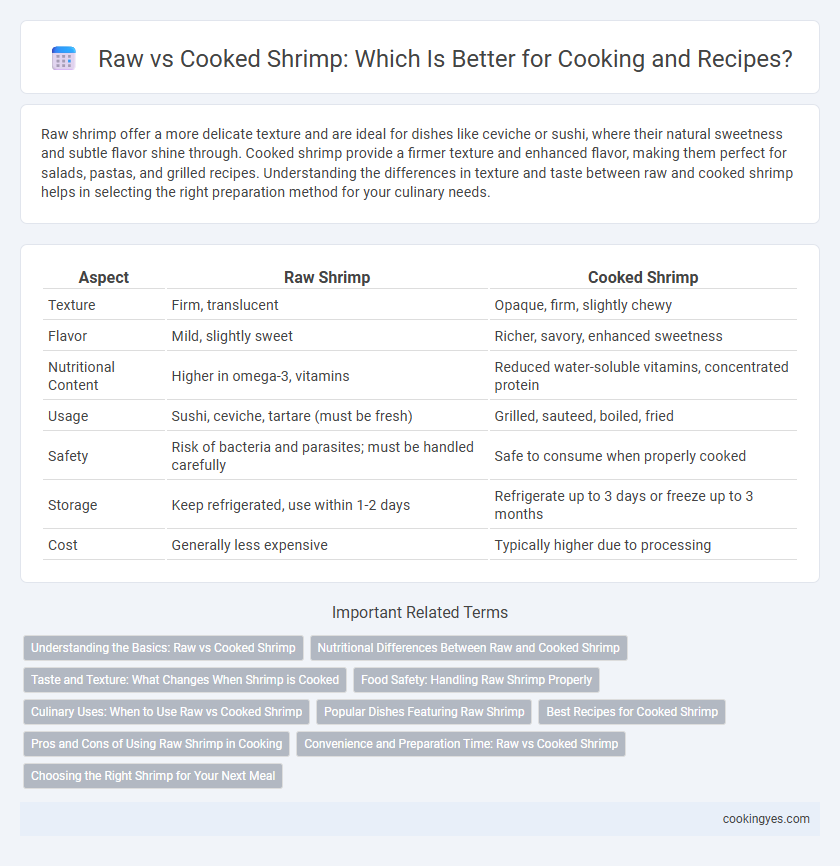Raw shrimp offer a more delicate texture and are ideal for dishes like ceviche or sushi, where their natural sweetness and subtle flavor shine through. Cooked shrimp provide a firmer texture and enhanced flavor, making them perfect for salads, pastas, and grilled recipes. Understanding the differences in texture and taste between raw and cooked shrimp helps in selecting the right preparation method for your culinary needs.
Table of Comparison
| Aspect | Raw Shrimp | Cooked Shrimp |
|---|---|---|
| Texture | Firm, translucent | Opaque, firm, slightly chewy |
| Flavor | Mild, slightly sweet | Richer, savory, enhanced sweetness |
| Nutritional Content | Higher in omega-3, vitamins | Reduced water-soluble vitamins, concentrated protein |
| Usage | Sushi, ceviche, tartare (must be fresh) | Grilled, sauteed, boiled, fried |
| Safety | Risk of bacteria and parasites; must be handled carefully | Safe to consume when properly cooked |
| Storage | Keep refrigerated, use within 1-2 days | Refrigerate up to 3 days or freeze up to 3 months |
| Cost | Generally less expensive | Typically higher due to processing |
Understanding the Basics: Raw vs Cooked Shrimp
Raw shrimp typically has a translucent appearance and a soft texture, while cooked shrimp turns opaque with a firm, slightly springy feel. Proper handling and storage of raw shrimp are crucial to prevent bacterial contamination and foodborne illnesses. Understanding these differences ensures optimal flavor and safety when incorporating shrimp into recipes.
Nutritional Differences Between Raw and Cooked Shrimp
Raw shrimp contains higher levels of omega-3 fatty acids and certain heat-sensitive vitamins such as vitamin B12, which diminish during cooking. Cooking shrimp increases protein digestibility and eliminates harmful bacteria, but it also reduces some minerals like potassium and selenium. Overall, cooked shrimp provides safer consumption with enhanced protein bioavailability, while raw shrimp offers superior preservation of delicate nutrients.
Taste and Texture: What Changes When Shrimp is Cooked
Raw shrimp have a translucent, slightly firm texture and a mild, oceanic flavor that intensifies when cooked. Cooking shrimp transforms its flesh to an opaque white with pink and red accents, while the texture becomes firmer, juicier, and more succulent. Heat enhances the natural sweetness and brings out a richer, more savory taste compared to raw shrimp.
Food Safety: Handling Raw Shrimp Properly
Handling raw shrimp properly is essential to prevent foodborne illnesses caused by bacteria like Vibrio and Salmonella. Always keep raw shrimp refrigerated at or below 40degF (4degC) and avoid cross-contamination by using separate cutting boards and utensils for raw seafood. Washing hands thoroughly before and after handling raw shrimp reduces the risk of transferring harmful pathogens to other foods or surfaces.
Culinary Uses: When to Use Raw vs Cooked Shrimp
Raw shrimp is ideal for ceviche, sushi, or dishes requiring marination where shrimp cooks in acidic ingredients, preserving its tender texture and fresh flavor. Cooked shrimp is preferred for salads, pasta, or shrimp cocktails, offering firm texture and enhanced seafood taste that stands out in cold or hot preparations. Understanding the shrimp's usage context ensures optimal texture and flavor balance in culinary applications.
Popular Dishes Featuring Raw Shrimp
Raw shrimp is a key ingredient in popular dishes like shrimp ceviche, where its fresh and tender texture enhances the vibrant flavors of citrus and herbs. Sushi and sashimi often feature raw shrimp, highlighting its sweet taste and delicate mouthfeel. Using raw shrimp in these dishes requires strict freshness standards to ensure safety and optimal flavor.
Best Recipes for Cooked Shrimp
Cooked shrimp offers enhanced flavor and texture ideal for diverse recipes like shrimp scampi, shrimp cocktail, and shrimp fried rice. Using cooked shrimp reduces cooking time and ensures food safety, especially in dishes that require quick assembly or grilling. Incorporating herbs, spices, and citrus can elevate the taste, making cooked shrimp a versatile ingredient for salads, pasta, and seafood platters.
Pros and Cons of Using Raw Shrimp in Cooking
Raw shrimp offers a tender texture and subtle flavor that can enhance dishes like ceviche and sushi, but it carries a higher risk of bacterial contamination and foodborne illnesses if not handled or stored properly. Using raw shrimp preserves nutrients such as omega-3 fatty acids and vitamins that may diminish during cooking, yet it requires strict sourcing from reputable suppliers to ensure safety. Conversely, cooked shrimp provides convenience and reduces health risks but loses some delicate taste and nutritional value found in raw shrimp.
Convenience and Preparation Time: Raw vs Cooked Shrimp
Raw shrimp require thorough cleaning and deveining before cooking, which can increase preparation time but allow customization of seasoning and cooking methods. Cooked shrimp offer convenience by being ready to eat or quickly added to dishes without further cooking, saving significant time during meal preparation. Choosing between raw and cooked shrimp depends on the desired balance between customization, freshness, and time efficiency in cooking.
Choosing the Right Shrimp for Your Next Meal
Selecting the right shrimp for your next meal depends on whether you plan to use raw or cooked shrimp. Raw shrimp offers maximum versatility and a fresher flavor profile, ideal for dishes like ceviche or sushi, while cooked shrimp provides convenience and a firmer texture suitable for salads and pastas. Pay attention to shrimp size, freshness, and sourcing; wild-caught shrimp often deliver superior taste and texture compared to farmed options.
Raw vs Cooked for shrimp usage Infographic

 cookingyes.com
cookingyes.com